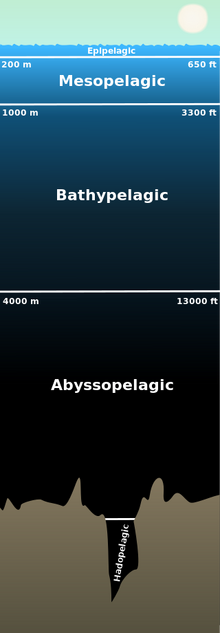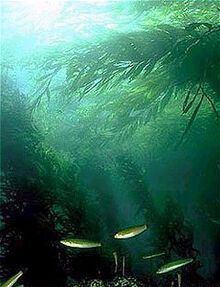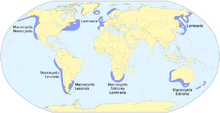
Under the waves are civilizations unseen by any human except for scant sightings of Nereids and other folk of the sea. As you can see, the regions of the sea are divided into several territories. Land based territories are placed with interest. The scale isn't given, but a similar map should give you the scale.
Marine Life Basics[]
Although this is introduced in detail in Cerulean Seas, it would be wonderful to go over it again. Marine Life lives in several zones under the sea, and most marine life that we are familair with congregates on the continental shelves. This is the shallow zone (shallow being the operative word). Life also exists in depths below this, and only five percent of the oceans have been explored in the Real World.[1]
The first thing humans usually experience is the beach or strand. I don't know why they call it a strand, but they do. Anyhow, waves crash on to the beach and usually deposit sand and other materials. Sea life associated with the beach are usually life that lives in the intertidal zone. That is, life that is associated with the tides -- including sea stars, snails, crabs, chitons, isopods, limpets, mussels, sea anemones, barnacles, and whelks. These are life that has adapted to the life of having powerful waves crashed against you or being carried out to sea by undertows.[2]
Littorial Zones[]
Littorial zones, which are near the coasts, are divided into three zones. The Supralittorial zone, the Littorial Zone, and the sub-littorial zone. The Supra-zone is also called the Spray Zone, and it is underwater only during storms. It exists between dry land and the high tidal zone. The littoral zone includes the land between the tidal zones and is called the intertidal zone. [3] The sublittoral zone is always underwater and always below the tideline. It extends all the way to the area where the continental shelf drops off into the abyssal plain.
Pelagic Zones[]

Everything except areas near the coast and near the sea floor is called the pelagic zone. The pelagic zone is divided into the epipelagic, mesopelagic, bathypelagic, abyssopelagic, and hadopelagic zones.
The pelagic zone occupies 1,330 million km3 (320 million mi3) with a mean depth of 3.68 km (2.29 mi) and maximum depth of 11 km (6.8 mi).[1][2][3] Fish that live in the pelagic zone are called pelagic fish. Pelagic life decreases with increasing depth. It is affected by light intensity, pressure, temperature, salinity, the supply of dissolved oxygen and nutrients, and the submarine topography. In deep water, the pelagic zone is sometimes called the open-ocean zone and can be contrasted with water that is near the coast or on the continental shelf. In other contexts, coastal water not near the bottom is still said to be in the pelagic zone. (retrieved from Wikipedia). [4]
The Photic Zone[]
The photic zone, euphotic zone (Greek for "well lit": εὖ "well" + φῶς "light"), or sunlight zone is the depth of the water in a lake or ocean that is exposed to such intensity of sunlight which designates compensation point, i.e. the intensity of light at which the rate of carbon dioxide uptake, or equivalently, the rate of oxygen production, is equal to the rate of carbon dioxide production, equivalently to the rate of oxygen consumption, reducing thus the net carbon dioxide assimilation to zero. (retrieved from Wikipedia).
The Pelagic Zone[]
Any water in a sea or lake that is neither close to the bottom nor near the shore can be said to be in the pelagic zone. The word "pelagic" is derived from Greek πέλαγος (pélagos), meaning "open sea". The pelagic zone can be thought of in terms of an imaginary cylinder or water column that goes from the surface of the sea almost to the bottom. Conditions differ deeper in the water column; the pressure increases, the temperature drops and less light penetrates. Depending on the depth, the water column, rather like the Earth's atmosphere, can be divided into different layers.
The pelagic zone occupies 1,330 million km3 (320 million mi3) with a mean depth of 3.68 km (2.29 mi) and maximum depth of 11 km (6.8 mi).[1][2][3] Fish that live in the pelagic zone are called pelagic fish. Pelagic life decreases with increasing depth. It is affected by light intensity, pressure, temperature, salinity, the supply of dissolved oxygen and nutrients, and the submarine topography. In deep water, the pelagic zone is sometimes called the open-ocean zone and can be contrasted with water that is near the coast or on the continental shelf. In other contexts, coastal water not near the bottom is still said to be in the pelagic zone.

Kelp forest photograph by Kip Evans (p.d.)
Epipelagic fish inhabit the epipelagic zone or the photic zone. The epipelagic zone is the water from the surface of the sea down to 200 metres. It is also referred to as the surface waters or the sunlit zone, and includes the photic zone. The photic zone is defined as the surface waters down to the point where the sunlight has attenuated to 1 percent of the surface value. This depth depends on how turbid the water is, but in clear water can extend to 200 metres, coinciding with the epipelagic zone. The photic zone has sufficient light for phytoplankton to photosynthese.[5]
The epipelagic zone is vast, and is the home for most pelagic fish. The zone is well lit so visual predators can use their eyesight, is usually well mixed and oxygenated from wave action, and can be a good habitat for algae to grow. However, it is an almost featureless habitat. This lack of habitat diversity results in a lack of species diversity, so the zone supports less than 2 percent of the world's known fish species. Much of the zone lacks nutrients for supporting fish, so epipelagic fish tend to be found in coastal water above the continental shelves, where land runoff can provide nutrients, or in those parts of the ocean where upwelling moves nutrients into the area.[5]
Epipelagic fish can be broadly divided into small forage fish and larger predator fish which feed on them. Forage fish schooland filter feed on plankton. Most epipelagic fish have streamlined bodies capable of sustained cruising on migrations. In general, predatory and forage fish share the same morphological features. Predator fish are usually fusiform with large mouths, smooth bodies, and deeply forked tails. Many use vision to predate zooplankton or smaller fish, while others filter feed on plankton.[5][6]
Coral Reefs and Kelp Forests[]

Coral reef locations around the world. (p.d.)
It is also in the epipelagic zone and the pelagic zone that you get coral reefs like the Great Barrier Reef or the Caribbean Reef; and kelp forests. It is amongst the coral reefs and kelp forests that most undersea civilizations -- such as the Nereids or Sea Folk kingdoms, are found. Coral reefs are found in tropical and sub-tropical waters while the kelp forests are found in temperate waters.[7][8]
Kelp forests are underwater areas with a high density of kelp. They are recognized as one of the most productive and dynamic ecosystems on Earth. Smaller areas of anchored kelp are called kelp beds.
| “ | "I can only compare these great aquatic forests…with the terrestrial ones in the inter tropical regions. Yet if in any country a forest was destroyed, I do not believe so nearly so many species of animals would perish as would here, from the destruction of kelp. Amdist the leaves of this plant numerous species of fish live, which nowhere else could find food or shelter; with their destruction the many cormorants and other fishing birds, the otters, seals and porpoise, would soon perish also; and lastly, the Fuegian[s]...would...decrease in numbers and perhaps cease to exist. | ” |
| — – Charles Darwin, 1 June 1834, Tierra del Fuego, Chile[9] | ||

Kelp forest distribution map by Maximilian Dörrbecker (Chumwa) (CC-by-SA).
Kelp forests occur worldwide throughout temperate and polar coastal oceans. In 2007, kelp forests were also discovered in tropical waters near Ecuador.
Physically formed by brown macroalgae of the order Laminariales, kelp forests provide a unique three-dimensional habitat for marine organisms and are a source for understanding many ecological processes. Over the last century, they have been the focus of extensive research, particularly in trophic ecology, and continue to provoke important ideas that are relevant beyond this unique ecosystem. For example, kelp forests can influence coastal oceanographic patterns and provide many ecosystem services. (retrieved from Wikipedia).
Kingdoms under the Waves[]
The Tritonis Imperium[]
The Undersea's version of the Roman Empire, the Tritonis Imperium is managed by the Tritons, humanoid beings from the Elemental Plane of Water. The Tritons came through gates leading to the material plane, in this case, the planet of Lemurias, and started a couple of colonies. The Tritons founded Tritonia, named after themselves. The empire they manage is vast, and they have their sights on consolidating the entire Mediterranean in one great empire. However, all the peoples are few and scattered, and several of the kingdoms are organized. So far, the Tritons have succeeded in taking over Piscean Territory. The Imperium is ruled by a Republic.
Free Pisceans[]
The Pisceans used to have a treaty with the Sahaugin, but wars with the Tritons and their range of expansion has caused them to turn to the Nereids for help. After a Triton defeat near Rome (ironically), large swaths of territory was claimed by the Pisceans, declaring themselves free. They have yet to organize themselves, but so far, the free Pisceans rely on a limited, voluntarist government.
Amphian Territories[]
Near the costal cities of the Phoenicians, lie the Amphian tribes. They have lost much of their territory to the Tritonis Imperium, but they manage to swim in small schools along the part of northern Lybia claimed by the Phoenician Republic. The Amphian tribes that swim here rely on a strictly patriarchal government, having recently discarded the matriarchal form of government. This was in response to the aggressive expansion policies of the Tritonis Imperium.
Thallassia Shashella[]
Thallassia Shashella is the land of the Sea Elves' expansive territory and kingdoms. Lately, the nearby Sahaugin have been chipping away at their power, and several settlements of Sea Elves allied with the Tritons to fend them off. So, Slowly, the Tritonis Imperium have been annexing both Sahuagin and Sea Elf territory. Here, the Sea Elves work hard in recreating Arvandor by using marine plants and coral reefs. They have been largely successful. However, strangely, the sahuagin have been locked in bloody war with the Sea Elves for quite a long time, mostly because of the effect Sea Elves have on sahuagin births. When a sahuagin camp is close to a Sea Elf settlement, one in five hundred eggs results in a sea elf hatching (called a Malenti). Both races are perplexed as to why this is happening.
The Kingdom of Sebek[]
The Kingdom of Sebek is an undersea kingdom made up of Anthro-Crocodiles called the Sebek-ka. Despite that a Dragonborn managed to crossbreed his race with crocodiles using the techniques to create the Anthropithikenes, during the pre-dynastic period of Khem true feats of fleshcrafting was attained. One of these was the creation of the sebek-kas. When the Old Kingdom collapsed into the first intermediate period, the Sebek-kas rebelled, left Egypt, and settled in the seas beyond the delta and the red sea region. When the Israelites left Egypt for their land in Phoenicia, the Sebek-kas were non-plussed about part of their geography being drained to allow the Israelites passage.
The Capital of the kingdom of Sebek is the city Sobekan, located on the eastern cape of the Red Sea. The Sebek-kas have settlements up and down the coast, except where the Israelites had treaded. The Sebek-kas have a complex culture based on Dynastic Egypt and keeps alive this culture. Their ruler is called the Pharoah. The Sebek-kas does not accept the Parmenian Pharoah to be their Pharoah, however, and have called one of their own to be Pharoah.
The Undersea Kingdoms of the Nereids[]
Aquatica Meridanis[]
Off the shore of Phaeselis is the small undersea kingdom of Aquatica Meridanis. Created by Nereids, the small kingdom is beleaguered by attacks from Sahuagin. Since the territories of the Sahuagin are off Phoenicia's shores, the kingdom suffers attacks, even though the fish-men have been known to overrun the coast. The Seafolk of the small kingdom have a greek-like culture, like the city of Phaeselis, and are often regimented in nature. Most PCs that encounter the merfolk in the region are merfolk of this particular region (representing the Merfolk culture described in the bestiary).
Aquatica Nereides[]
A large undersea kingdom in the Aegean Sea, ruled by the powerful queen Amphitrite. Aquatica Nereides is based in Nereus, a city named after the Old Man of the Sea (Noah). Once a great Empire flourished under the waves, and ranged from the Adriatic Sea to the seas of Phoenicia, but Sahuagin attacks and Triton Expansion has reduced this undersea empire to all but three kingdoms, and Aquatica Nereides is the most powerful of the three.
With cities built of coral and bronze, the Queen of the Sea rules with absolute power, power she rarely abuses. The empire was built by Philip, her great grandfather and is often referred to as the Alexander of the Seas. The people here are not like the people of their sister kingdom, Aquatica Meridanis. They are amicable and willing to help drowning sailors.
Aquatica Psionica[]
The Undersea counterpart to Phaeselis, City of Psionics. This is an entire kingdom under the Adriatic Sea of psionic Nereids. They keep their secrets under close guardianship and study, and have been managing to keep the Nommos and the Tritons in check with their powers. Their capital is Psycheon.
Aquatica Atlantica[]
An Empire of Nereids stretching from the Azores islands to the Isles of the Serpent (the Canary Islands) and beyond to the Cape of South Africa. Aquatica Altantica is the largest empire of the Nereids, except those that dwell in the seas of the Hesperides. The border is the Pillars of Hercules. The Empire was founded by settlers from Aquatica Nereides. These folk are adventuring, hardy folk that have conquered the seas along the western coast of Tarshish and the western coast of the whole land of Lybia.
Aquatica Britannia[]
Under what we now call the English Channel is a small kingdom of Nereids. Made of hardy stock built for northern seas, the Britannians are ruled by a King who keeps his kingdom hidden from the humans on either side. Being so far away from their kin in the Great Sea, the Britannian folk are independent, feirce, and mighty. Although they are also amicable and have been known to save drowning sailors from their fate. The kingdom has existed since the Blessed Isles' Bronze Age.
References[]
- ↑ Emily Ember Kubisz, J. Matthew Kubisz, Matthew A. Cicci, & Sam G. Hing (2010). Cerulean Seas Campaign Setting, p. 16. Alluria Publishing.
- ↑ Marine Zones (Article). MarineBio.org. Retrieved on 2015-01-11.
- ↑ Marine Zones (Article). MarineBio.org. Retrieved on 2015-01-11.
- ↑ Pelagic Zone (wiki article). Wikipedia. Retrieved on 2015-01-11.
- ↑ Marine Zones (Article). MarineBio.org. Retrieved on 2015-01-11.
- ↑ Epipelagic Fish (Wiki Article section). Wikipedia. Retrieved on 2015-01-11.
- ↑ Emily Ember Kubisz, J. Matthew Kubisz, Matthew A. Cicci, & Sam G. Hing (2010). Cerulean Seas Campaign Setting, p. 17. Alluria Publishing.
- ↑ Emily Ember Kubisz, J. Matthew Kubisz, Matthew A. Cicci, & Sam G. Hing (2010). Cerulean Seas Campaign Setting, p. 19. Alluria Publishing.
- ↑ Charles Darwin (1839, November 2013). Voyage of the Beagle, p. 3. Beagle Press. ISBN 1619492814.